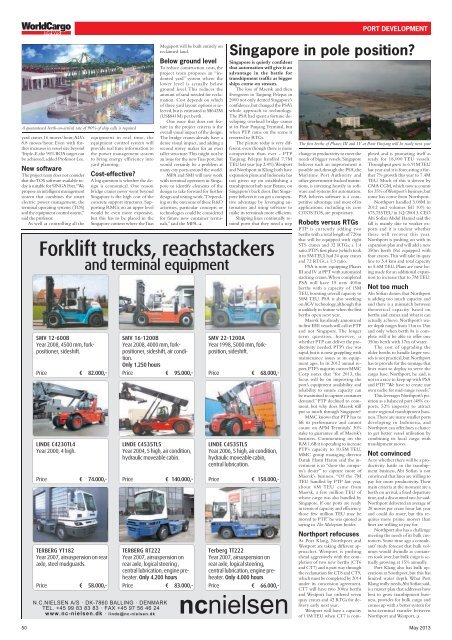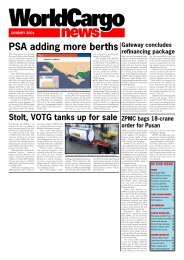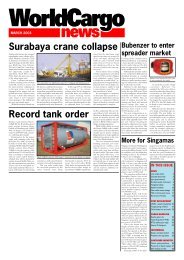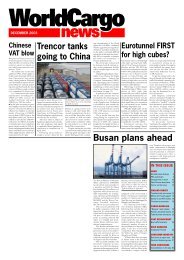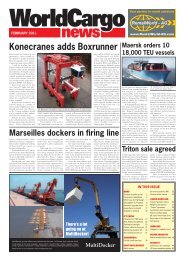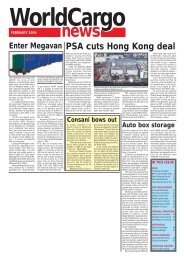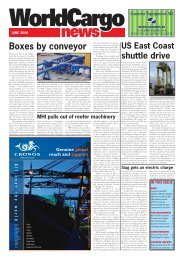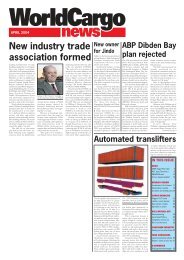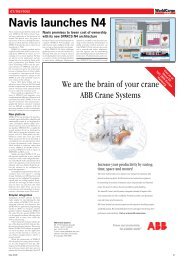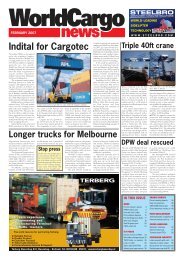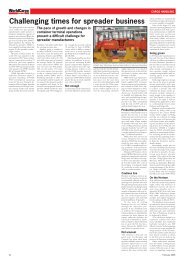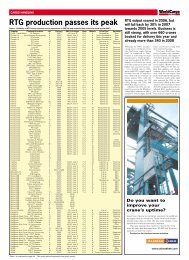Tanjung Priok super port - WorldCargo News Online
Tanjung Priok super port - WorldCargo News Online
Tanjung Priok super port - WorldCargo News Online
Create successful ePaper yourself
Turn your PDF publications into a flip-book with our unique Google optimized e-Paper software.
<strong>WorldCargo</strong><br />
news<br />
A guaranteeed berth-on-arrival rate of 90% of ship calls is required<br />
yard cranes 16 moves/hour, ALVs<br />
8.8 moves/hour. Even with further<br />
increases in vessel size beyond<br />
Triple-E, the 90% BOA target can<br />
be achieved, added Professor Lee.<br />
New software<br />
The project team does not consider<br />
that the TOS software available today<br />
is suitable for SINGA Port. “We<br />
propose an intelligent management<br />
system that combines the smart<br />
electric power management, the<br />
terminal operating systems (TOS)<br />
and the equipment control system,”<br />
said the professor.<br />
As well as controlling all the<br />
equipment in real time, the<br />
equipment control system will<br />
provide real time information to<br />
the power management system<br />
to bring energy efficiency into<br />
yard planning.<br />
Cost-effective<br />
A big question is whether the design<br />
is economical. One reason<br />
bridge cranes never went beyond<br />
Singapore is the high cost of the<br />
concrete sup<strong>port</strong> structures. Sup<strong>port</strong>ing<br />
RMGs on an upper level<br />
would be even more expensive,<br />
but this has to be placed in the<br />
Singapore context where the Tuas<br />
Mega<strong>port</strong> will be built entirely on<br />
reclaimed land.<br />
Below ground level<br />
To reduce construction costs, the<br />
project team proposes an “indented<br />
yard” system where the<br />
lower level is actually below<br />
ground level. This reduces the<br />
amount of sand needed for reclamation.<br />
Cost depends on which<br />
of three yard layout options is selected,<br />
but is estimated at S$642M<br />
(US$841M) per berth.<br />
One issue that does not feature<br />
in the project criteria is the<br />
overall visual impact of the design.<br />
The bridge cranes already have a<br />
dense visual impact, and adding a<br />
second storey makes for an even<br />
taller structure. This might not be<br />
an issue for the new Tuas <strong>port</strong>, but<br />
would certainly be a problem at<br />
many city <strong>port</strong>s around the world.<br />
MPA and SMI will now work<br />
with terminal operators in Singapore<br />
to identify elements of the<br />
design to take forward for further<br />
design and testing work. “Depending<br />
on the outcome of these R&D<br />
activities, particular concepts or<br />
technologies could be considered<br />
for future new container terminals,”<br />
said the MPA. ❏<br />
Singapore is quietly confident<br />
that automation will give it an<br />
advantage in the battle for<br />
transhipment traffic as bigger<br />
ships come on stream.<br />
The loss of Maersk and then<br />
Evergreen to <strong>Tanjung</strong> Pelepas in<br />
2000 not only dented Singapore’s<br />
confidence, but changed the PSA’s<br />
whole approach to technology.<br />
The PSA had spent a fortune developing<br />
overhead bridge cranes<br />
at its Pasir Panjang Terminal, but<br />
when PTP came on the scene it<br />
reverted to RTGs.<br />
The picture today is very different,<br />
even though there is more<br />
competition than ever - PTP<br />
<strong>Tanjung</strong> Pelepas handled 7.7M<br />
TEU last year (up 2.4%). West<strong>port</strong><br />
and North<strong>port</strong> in Klang both have<br />
expansion plans and Indonesia has<br />
not given up on establishing a<br />
transhipment hub near Batam, on<br />
Singapore’s back door. But Singapore<br />
believes it can get a competitive<br />
advantage by leveraging automation<br />
and using software to<br />
make its terminals more efficient.<br />
Shipping lines continually remind<br />
<strong>port</strong>s that they need a step<br />
Forklift trucks, reachstackers<br />
and terminal equipment<br />
SMV 12-600B<br />
Year 2008, 4500 mm, forkpositioner,<br />
sideshift.<br />
Price € 82.000,-<br />
LINDE C4230TL4<br />
Year 2000, 4 high.<br />
Price € 74.000,-<br />
TERBERG YT182<br />
Year 2007, airsuspension on rear<br />
axle, steel mudguards.<br />
Price € 58.000,-<br />
SMV 16-1200B<br />
Year 2008, 4000 mm, forkpositioner,<br />
sideshift, air condition.<br />
Only 1.250 hours<br />
Price € 95.000,-<br />
LINDE C4535TL5<br />
Year 2004, 5 high, air condition,<br />
hydraulic moveable cabin.<br />
Price € 140.000,-<br />
TERBERG RT222<br />
Year 2007, airsuspension on<br />
rear axle, logical steering ,<br />
central lubrication, engine preheater.<br />
Only 4.200 hours<br />
Price € 83.000,-<br />
N.C.NIELSEN A/S · DK-7860 BALLING · DENMARK<br />
TEL. +45 99 83 83 83 · FAX +45 97 56 46 24<br />
www.nc-nielsen.dk · linde@nc-nielsen.dk<br />
change in productivity to meet the<br />
needs of bigger vessels. Singapore<br />
believes such an improvement is<br />
possible and, through the PSA, the<br />
Maritime Port Authority and<br />
other government-backed institutions,<br />
is investing heavily in software<br />
and systems for automation.<br />
PSA believes software is a competitive<br />
advantage and most of its<br />
applications, including its core<br />
CiTOS TOS, are proprietary.<br />
Robots versus RTGs<br />
PTP is currently adding two<br />
berths with a total length of 720m<br />
that will be equipped with eight<br />
STS cranes and 32 RTGs, a 1:4<br />
ratio. PTP’s first phase (which took<br />
it to 5M TEU) had 24 quay cranes<br />
and 72 RTGs, a 1:3 ratio.<br />
PSA is now equipping Phases<br />
III and IV at PPT with automated<br />
stacking cranes. When completed<br />
PSA will have 15 new 400m<br />
berths with a capacity of 15M<br />
TEU, boosting overall capacity to<br />
50M TEU. PSA is also working<br />
on AGV technology, although this<br />
is unlikely to feature when the first<br />
berths open next year.<br />
Maersk has already announced<br />
its first EEE vessels will call at PTP<br />
and not Singapore. The longer<br />
term question, however, is<br />
whether PTP can deliver the productivity<br />
needed. PTP’s rise was<br />
rapid, but it is now grappling with<br />
maintenance issues as its equipment<br />
ages. In its 2012 annual re<strong>port</strong>,<br />
PTP’s majority owner MMC<br />
Corp notes that “for 2013, the<br />
focus will be on improving the<br />
<strong>port</strong>’s equipment availability and<br />
reliability to ensure capacity can<br />
be maximised to capture container<br />
demand.” PTP declined to comment,<br />
but why does Maersk still<br />
put so much through Singapore<br />
MMC knows that PTP has to<br />
lift its performance and cannot<br />
count on APM Terminals’ 30%<br />
stake to guarantee all of Maersk’s<br />
business. Commenting on the<br />
RM 1.6B it is spending to increase<br />
PTP’s capacity to 10.5M TEU,<br />
MMC group managing director<br />
Datuk Hasni Harun said the investment<br />
is to “show the company’s<br />
desire” to capture more of<br />
Maersk’s business. “Of the 7M<br />
TEU handled by PTP last year,<br />
about 6M TEU came from<br />
Maersk, a few million TEU of<br />
whose cargo was also handled by<br />
Singapore. If our <strong>port</strong>s are ready<br />
in terms of capacity and efficiency,<br />
those few million TEU may be<br />
moved to PTP,” he was quoted as<br />
saying in The Malaysian Insider.<br />
PORT DEVELOPMENT<br />
Singapore in pole position<br />
SMV 22-1200A<br />
Year 1998, 5000 mm, forkposition,<br />
sideshift.<br />
Price € 68.000,-<br />
LINDE C4535TL5<br />
Year 2006, 5 high, air condition,<br />
hydraulic moveable cabin,<br />
central lubrication.<br />
Price € 158.000,-<br />
Terberg TT222<br />
Year 2007, airsuspension on<br />
rear axle, logical steering,<br />
central lubrication, engine preheater.<br />
Only 4.000 hours<br />
Price € 66.000,-<br />
ncnielsen<br />
The first berths of Phases III and IV at Pasir Panjang will be ready next year<br />
North<strong>port</strong> refocuses<br />
At Port Klang, North<strong>port</strong> and<br />
West<strong>port</strong> are taking different approaches.<br />
West<strong>port</strong> is pushing<br />
ahead aggressively with the completion<br />
of two new berths (CT6<br />
and CT7) and is part way through<br />
the reclamation for CT8 and CT9,<br />
which must be completed by 2014<br />
under its concession agreement.<br />
CT7 will have two 300m berths<br />
and West<strong>port</strong> has ordered seven<br />
quay cranes and 42 RTGs for delivery<br />
early next year.<br />
West<strong>port</strong> will have a capacity<br />
of 11M TEU when CT7 is completed<br />
and is promoting itself as<br />
ready for 18,000 TEU vessels.<br />
Throughput grew to 6.91M TEU<br />
last year and it is forecasting a further<br />
7% growth this year to 7.4M<br />
TEU. Much of this is driven by<br />
CMA CGM, which now accounts<br />
for 35% of West<strong>port</strong>’s business, but<br />
some has come from North<strong>port</strong>.<br />
North<strong>port</strong> handled 3.08M in<br />
2012 and volumes fell 10% to<br />
675,755TEU in 1Q/20013. CEO<br />
Abi Sofian Abdul Hamid said the<br />
fall is mainly due to weaker ex<strong>port</strong>s<br />
and it is unclear whether<br />
these will recover this year.<br />
North<strong>port</strong> is pushing on with its<br />
expansion plan and will add a new<br />
350m berth (8a) equipped with<br />
four cranes. This will take its quay<br />
line to 3.4 kms and total capacity<br />
to 5.6M TEU. Plans are now being<br />
made for an additional expansion<br />
to increase that to 7M TEU.<br />
Not too much<br />
Abi Sofian denies that North<strong>port</strong><br />
is adding too much capacity and<br />
said there is a mismatch between<br />
theoretical capacity based on<br />
berths and cranes and what it can<br />
actually achieve. North<strong>port</strong>’s water<br />
depth ranges from 11m to 15m<br />
and only when berth 8a is complete<br />
will it be able to offer one<br />
350m berth with 17m of water.<br />
The cost of upgrading the<br />
older berths to handle larger vessels<br />
is not practical, but North<strong>port</strong><br />
has to provide for the tonnage that<br />
lines want to deploy to serve the<br />
cargo base. North<strong>port</strong>, he said, is<br />
not in a race to keep up with PSA<br />
and PTP. “We have to create our<br />
own niche for mid-range vessels.”<br />
This leverages North<strong>port</strong>’s position<br />
as a balanced <strong>port</strong> (48% ex<strong>port</strong>s,<br />
52% im<strong>port</strong>s) to attract<br />
more regional transhipment business.<br />
There are many smaller <strong>port</strong>s<br />
developing in Indonesia, and<br />
North<strong>port</strong> can offer lines a chance<br />
to get better vessel utilisation by<br />
combining its local cargo with<br />
transhipment moves.<br />
Not convinced<br />
As to whether there will be a productivity<br />
battle in the transhipment<br />
business, Abi Sofian is not<br />
convinced that lines are willing to<br />
pay for more productivity. Their<br />
main criteria at the moment are a<br />
berth on arrival, a fixed departure<br />
time, and a discounted rate, he said.<br />
North<strong>port</strong> delivered an average of<br />
28 moves per crane hour last year<br />
and could do more, but this requires<br />
more prime movers than<br />
lines are willing to pay for.<br />
North<strong>port</strong> also has a challenge<br />
meeting the needs of its bulk customers.<br />
Some time ago a consultants’<br />
study forecast that bulk volumes<br />
would dwindle as containers<br />
took over, but bulk cargo is actually<br />
growing at 15% annually.<br />
Port Klang also has bulk operations<br />
at South<strong>port</strong>, but this has<br />
limited water depth. What Port<br />
Klang really needs, Abi Sofian said,<br />
is a master plan that addresses how<br />
best to grow transhipment business,<br />
provides for bulk cargo and<br />
comes up with a better system for<br />
intra-terminal transfer between<br />
North<strong>port</strong> and West<strong>port</strong>. ❏<br />
50<br />
May 2013


